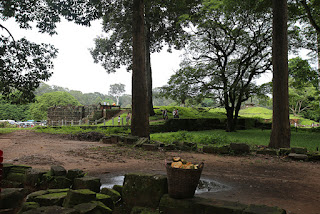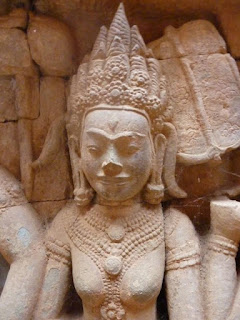Terrace of the Leper King, Angkor, Cambodia.
ระเบียง พระยม พระยมราช หรือ มัจจุราช (พระเจ้าขี้เรื้อน) เมืองพระนคร จังหวัดเสียมเรียบ ราชอาณาจักรกัมพูชา.
The statue which gave the terrace its name has been replaced by a replica.
(From Wikipedia, the free encyclopedia)
*** รูปปั้นองค์ดั้งเดิมที่แกะสลักขึ้นมาชื่อว่า “พระยม พระยมราช หรือ มัจจุราช” ซึ่งหมายถึงเทพแห่งความตายของฮินดูชื่อว่า “ ยมะ” รูปปั้นนี้มีอายุตั้งแต่สมัยคริสต์ศตวรรษที่ 15 หลังจากที่สร้างลานแห่งนี้มาประมาณ 250 ปี
** The statue sepicts the Hindu god Yama,the god of Death.
ระเบียงพระเจ้าขี้เรื้อน เมืองพระนคร จังหวัดเสียมเรียบ ราชอาณาจักรกัมพูชา.
Terrace of the Leper King, Angkor, Cambodia.
Photo Gallery. Asian Historical Architecture.
ขอบคุณ ภาพและข้อมูล
จาก http://www.orientalarchitecture.com/sid/928/cambodia/angkor/terrace-of-the-leper-king
Terrace of the Leper King (13th century)
The so-called "Terrace of the Leper King" is located just to the north of the Elephant Terraces and is considered a part of the larger Royal Terraces ensemble, a 360 meter long sandstone wall that forms the eastern boundary of the Royal Palace area. The terrace is named after a statue of the "Leper King" that originally stood at the center of the terrace. The original statue now stands in the National Museum in Phnom Penh but a modern replica remains on site, kneeling in a 'Javanese' pose with his forearm supported by his right knee. The statue traditionally belonged to the "Leper King", Prince Preah Thong, an Indian who came to Cambodia to marry the daughter of the Naga King and found the city of Angkor. The association of this statue with this leprosy may have happened as a result of the statue's dilapidated appearance--its lichen-covered face and missing fingers and toes may have been mistaken by locals as a deliberate representation of leprosy. However, close examination of the statue--which was carved as a nude--show no traces of disease. Modern scholars believe the statue may represent either Shiva or perhaps Yama, the Hindu god of death. If this is correct, the terrace may have served as site for royal cremations (the placement of the terrace on the north side of the royal palace lends credence to this theory).
The most unusual aspect of the terrace is that it was built as a set of double walls with a narrow passage between them. For many years only the outer wall was visible as the narrow interior wall was wholly filled with dirt and rubble. This was actually a fortunate accident as the packed earth helped preserve the carvings on the inner wall. The debris was cleared away in the 1990s and visitors can now view the inner wall in its entirety.
Both sets of walls are constructed of sandstone and are arranged horizontally into seven tiers of sculptures, though the uppermost tier is mostly eroded. The most common recurring motifs are images of royal dignitaries, priests, nagas, and court ladies.
Site Plan

Drawn by Timothy M Ciccone following Claude Jacques, Michael Freeman, and Jean Laur.
Location
The approximate location of the site is 13.447599' N, 103.859077' E (WGS 84 map datum).
ระเบียง พระยม พระยมราช หรือ มัจจุราช (พระเจ้าขี้เรื้อน) เมืองพระนคร จังหวัดเสียมเรียบ ราชอาณาจักรกัมพูชา.
02.Terrace of the Leper King, Angkor, Cambodia. Photo Gallery. Asian Historical Architecture.
ระเบียง พระยม พระยมราช หรือ มัจจุราช (พระเจ้าขี้เรื้อน) เมืองพระนคร จังหวัดเสียมเรียบ ราชอาณาจักรกัมพูชา.
ระเบียง พระยม พระยมราช หรือ มัจจุราช (พระเจ้าขี้เรื้อน) เมืองพระนคร จังหวัดเสียมเรียบ ราชอาณาจักรกัมพูชา.
ระเบียง พระยม พระยมราช หรือ มัจจุราช (พระเจ้าขี้เรื้อน) เมืองพระนคร จังหวัดเสียมเรียบ ราชอาณาจักรกัมพูชา.
ระเบียง พระยม พระยมราช หรือ มัจจุราช (พระเจ้าขี้เรื้อน) เมืองพระนคร จังหวัดเสียมเรียบ ราชอาณาจักรกัมพูชา.
ระเบียง พระยม พระยมราช หรือ มัจจุราช (พระเจ้าขี้เรื้อน) เมืองพระนคร จังหวัดเสียมเรียบ ราชอาณาจักรกัมพูชา.
ระเบียง พระยม พระยมราช หรือ มัจจุราช (พระเจ้าขี้เรื้อน) เมืองพระนคร จังหวัดเสียมเรียบ ราชอาณาจักรกัมพูชา.
ระเบียง พระยม พระยมราช หรือ มัจจุราช (พระเจ้าขี้เรื้อน) เมืองพระนคร จังหวัดเสียมเรียบ ราชอาณาจักรกัมพูชา.
ระเบียง พระยม พระยมราช หรือ มัจจุราช (พระเจ้าขี้เรื้อน) เมืองพระนคร จังหวัดเสียมเรียบ ราชอาณาจักรกัมพูชา.
ระเบียง พระยม พระยมราช หรือ มัจจุราช (พระเจ้าขี้เรื้อน) เมืองพระนคร จังหวัดเสียมเรียบ ราชอาณาจักรกัมพูชา.
ระเบียง พระยม พระยมราช หรือ มัจจุราช (พระเจ้าขี้เรื้อน) เมืองพระนคร จังหวัดเสียมเรียบ ราชอาณาจักรกัมพูชา.
ระเบียง พระยม พระยมราช หรือ มัจจุราช (พระเจ้าขี้เรื้อน) เมืองพระนคร จังหวัดเสียมเรียบ ราชอาณาจักรกัมพูชา.
ระเบียง พระยม พระยมราช หรือ มัจจุราช (พระเจ้าขี้เรื้อน) เมืองพระนคร จังหวัดเสียมเรียบ ราชอาณาจักรกัมพูชา.
ระเบียง พระยม พระยมราช หรือ มัจจุราช (พระเจ้าขี้เรื้อน) เมืองพระนคร จังหวัดเสียมเรียบ ราชอาณาจักรกัมพูชา.
ระเบียง พระยม พระยมราช หรือ มัจจุราช (พระเจ้าขี้เรื้อน) เมืองพระนคร จังหวัดเสียมเรียบ ราชอาณาจักรกัมพูชา.
ระเบียง พระยม พระยมราช หรือ มัจจุราช (พระเจ้าขี้เรื้อน) เมืองพระนคร จังหวัดเสียมเรียบ ราชอาณาจักรกัมพูชา.
ระเบียง พระยม พระยมราช หรือ มัจจุราช (พระเจ้าขี้เรื้อน) เมืองพระนคร จังหวัดเสียมเรียบ ราชอาณาจักรกัมพูชา.
ระเบียง พระยม พระยมราช หรือ มัจจุราช (พระเจ้าขี้เรื้อน) เมืองพระนคร จังหวัดเสียมเรียบ ราชอาณาจักรกัมพูชา.
ระเบียง พระยม พระยมราช หรือ มัจจุราช (พระเจ้าขี้เรื้อน) เมืองพระนคร จังหวัดเสียมเรียบ ราชอาณาจักรกัมพูชา.
ระเบียง พระยม พระยมราช หรือ มัจจุราช (พระเจ้าขี้เรื้อน) เมืองพระนคร จังหวัดเสียมเรียบ ราชอาณาจักรกัมพูชา.
ระเบียง พระยม พระยมราช หรือ มัจจุราช (พระเจ้าขี้เรื้อน) เมืองพระนคร จังหวัดเสียมเรียบ ราชอาณาจักรกัมพูชา.
ระเบียง พระยม พระยมราช หรือ มัจจุราช (พระเจ้าขี้เรื้อน) เมืองพระนคร จังหวัดเสียมเรียบ ราชอาณาจักรกัมพูชา.
ระเบียง พระยม พระยมราช หรือ มัจจุราช (พระเจ้าขี้เรื้อน) เมืองพระนคร จังหวัดเสียมเรียบ ราชอาณาจักรกัมพูชา.
ระเบียง พระยม พระยมราช หรือ มัจจุราช (พระเจ้าขี้เรื้อน) เมืองพระนคร จังหวัดเสียมเรียบ ราชอาณาจักรกัมพูชา.
ระเบียง พระยม พระยมราช หรือ มัจจุราช (พระเจ้าขี้เรื้อน) เมืองพระนคร จังหวัดเสียมเรียบ ราชอาณาจักรกัมพูชา.
ระเบียง พระยม พระยมราช หรือ มัจจุราช (พระเจ้าขี้เรื้อน) เมืองพระนคร จังหวัดเสียมเรียบ ราชอาณาจักรกัมพูชา.
Terrace of the Leper King, Angkor, Cambodia.
Photo Gallery. Asian Historical Architecture.
ขอบคุณ ภาพและข้อมูล
จาก http://www.orientalarchitecture.com/sid/928/cambodia/angkor/terrace-of-the-leper-king
----------------------------------------------------------------
จาก https://en.wikipedia.org/wiki/Terrace_of_the_Leper_King
Terrace of the Leper King
From Wikipedia, the free encyclopedia
01.The statue which gave the terrace its name has been replaced by a replica.
The Terrace of the Leper King (or Leper King Terrace) (Khmer: ព្រះលានស្តេចគម្លង់, Preah Learn Sdech Kunlung) is located in the northwest corner of the Royal Square of Angkor Thom, Cambodia.
It was built in the Bayon style under Jayavarman VII, though its modern name derives from a 15th-century sculpture discovered at the site. The statue depicts the Hindu god Yama, the god of death.
The statue was called the "Leper King" because discolouration and moss growing on it was reminiscent of a person with leprosy, and also because it fit in with a Cambodian legend of an Angkorian king Yasovarman I who had leprosy.[1] The name that the Cambodians know him by, however, is Dharmaraja,[2] as this is what was etched at the bottom of the original statue.
The U-shaped structure is thought by some to have been used as a royal cremation site.
03.errace of the Leper King
04.Leper King's altar
-------------------------------------------------------------------
จาก http://www.photodharma.net/Cambodia/06-Leper-King/06-Leper-King.htm
The Leper King Terrace.
The Leper King Terrace is located near to Bayon. It was built in the Bayon style under Jayavarman VII, though its modern name derives from a 15th century sculpture discovered at the site. The statue depicts the Hindu god Yama, the god of Death. He was called the Leper King because discoloration and moss growing on the original statue was reminiscent of a person with leprosy, and also because of a Cambodian legend of an Angkorian king who had leprosy.
Text adapted from Wikipedia (retrieved, March 3rd 2010)
The first photograph above shows a replica of the the original statue, which is now in the National Museum, Phnom Phen. The second is of the terrace itself. Thereafter the photographs are of notable characters found on the walls. Notice the unfinished work on some of the reliefs, which were never completed.
Photographs by Anandajoti Bhikkhu
01.The Leper King Terrace. Photographs by Anandajoti Bhikkhu.
02.The Leper King Terrace. Photographs by Anandajoti Bhikkhu.
03.The Leper King Terrace. Photographs by Anandajoti Bhikkhu.
04.The Leper King Terrace. Photographs by Anandajoti Bhikkhu.
05.The Leper King Terrace. Photographs by Anandajoti Bhikkhu.
06.The Leper King Terrace. Photographs by Anandajoti Bhikkhu.
07.The Leper King Terrace. Photographs by Anandajoti Bhikkhu.
08.The Leper King Terrace. Photographs by Anandajoti Bhikkhu.
09.The Leper King Terrace. Photographs by Anandajoti Bhikkhu.
10.The Leper King Terrace. Photographs by Anandajoti Bhikkhu.
11.The Leper King Terrace. Photographs by Anandajoti Bhikkhu.
12.The Leper King Terrace. Photographs by Anandajoti Bhikkhu.
13.The Leper King Terrace. Photographs by Anandajoti Bhikkhu.
14.The Leper King Terrace. Photographs by Anandajoti Bhikkhu.
15.The Leper King Terrace. Photographs by Anandajoti Bhikkhu.
16.The Leper King Terrace. Photographs by Anandajoti Bhikkhu.
17.The Leper King Terrace. Photographs by Anandajoti Bhikkhu.
18.The Leper King Terrace. Photographs by Anandajoti Bhikkhu.
19.The Leper King Terrace. Photographs by Anandajoti Bhikkhu.
20.The Leper King Terrace. Photographs by Anandajoti Bhikkhu.

















































จาก http://www.thailandsworld.com/th/angkor/angkor-thom/terrace-of-the-leper-king/index.cfm
ตอบลบงานแกะสลักบริเวณลานพระเจ้าขี้เรื้อน
ด้านทิศเหนือสุดของลานช้างคือลานพระเจ้าขี้เรื้อนซึ่งมีขนาดใหญ่กว่า ลานนี้ตั้งชื่อตามรูปปั้นพระเจ้าขี้เรื้อน โดยจะมีรูปปั้นจำลองอยู่ด้านบนสุดของลาน ส่วนรูปพระเจ้าขี้เรื้อนองค์จริงเก็บรักษาอยู่ในพิพิธภัณฑสถานแห่งชาติพนมเปญ รูปปั้นองค์ดั้งเดิมที่แกะสลักขึ้นมาชื่อว่า “ ธรรมราชา” ซึ่งหมายถึงเทพแห่งความตายของฮินดูชื่อว่า “ ยมะ” รูปปั้นนี้มีอายุตั้งแต่สมัยคริสต์ศตวรรษที่ 15 หลังจากที่สร้างลานแห่งนี้มาประมาณ 250 ปี
ลานพระเจ้าขี้เรื้อนแห่งนี้สร้างโดยพระเจ้าชัยวรมันที่ 7 ในช่วงปลายคริสต์ศตวรรษที่ 12 เช่นกัน เนื่องจากรูปร่างลักษณะสำหรับให้ชมจากด้านบนและมีรูปปั้นเทพยมะ จึงถือว่าลานแห่งนี้ใช้สำหรับเป็นที่เผาศพ
ไม่มีหลักฐานทางประวัติศาสตร์ที่ยืนยันได้ว่าเหตุใดจึงเรียกรูปปั้นนี้ว่าพระเจ้าขี้เรื้อน มีตำนานหนึ่งเกี่ยวกับกษัตริย์พระองค์หนึ่งของเขมรซึ่งทรงพระประชวรเป็นโรคเรื้อน อีกฝ่ายหนึ่งก็บอกว่ารูปปั้นหินนี้มีไลเคนและมอสขึ้นจับตามตัวทำให้เกิดเป็นตะปุ่มตะป่ำเหมือนโรคเรื้อน แต่ว่าชื่อนี้ไม่มีที่มาที่ไปในทางประวัติศาสตร์
งานแกะสลักบริเวณลานพระเจ้าขี้เรื้อน ด้านทิศเหนือสุดของลานช้างคือลานพระเจ้าขี้เรื้อนซึ่งมีขนาดใหญ่กว่า ลานนี้ตั้งชื่อตามรูปปั้นพระเจ้าขี้เรื้อน โดยจะมีรูปปั้นจำลองอยู่ด้านบนสุดของลาน ส่วนรูปพระเจ้าขี้เรื้อนองค์จริงเก็บรักษาอยู่ในพิพิธภัณฑสถานแห่งชาติพนมเปญ รูปปั้นองค์ดั้งเดิมที่แกะสลักขึ้นมาชื่อว่า “ ธรรมราชา” ซึ่งหมายถึงเทพแห่งความตายของฮินดูชื่อว่า “ ยมะ” รูปปั้นนี้มีอายุตั้งแต่สมัยคริสต์ศตวรรษที่ 15 หลังจากที่สร้างลานแห่งนี้มาประมาณ 250 ปี ลานพระเจ้าขี้เรื้อนแห่งนี้สร้างโดยพระเจ้าชัยวรมันที่ 7 ในช่วงปลายคริสต์ศตวรรษที่ 12 เช่นกัน เนื่องจากรูปร่างลักษณะสำหรับให้ชมจากด้านบนและมีรูปปั้นเทพยมะ จึงถือว่าลานแห่งนี้ใช้สำหรับเป็นที่เผาศพ ไม่มีหลักฐานทางประวัติศาสตร์ที่ยืนยันได้ว่าเหตุใดจึงเรียกรูปปั้นนี้ว่าพระเจ้าขี้เรื้อน มีตำนานหนึ่งเกี่ยวกับกษัตริย์พระองค์หนึ่งของเขมรซึ่งทรงพระประชวรเป็นโรคเรื้อน อีกฝ่ายหนึ่งก็บอกว่ารูปปั้นหินนี้มีไลเคนและมอสขึ้นจับตามตัวทำให้เกิดเป็นตะปุ่มตะป่ำเหมือนโรคเรื้อน แต่ว่าชื่อนี้ไม่มีที่มาที่ไปในทางประวัติศาสตร์.